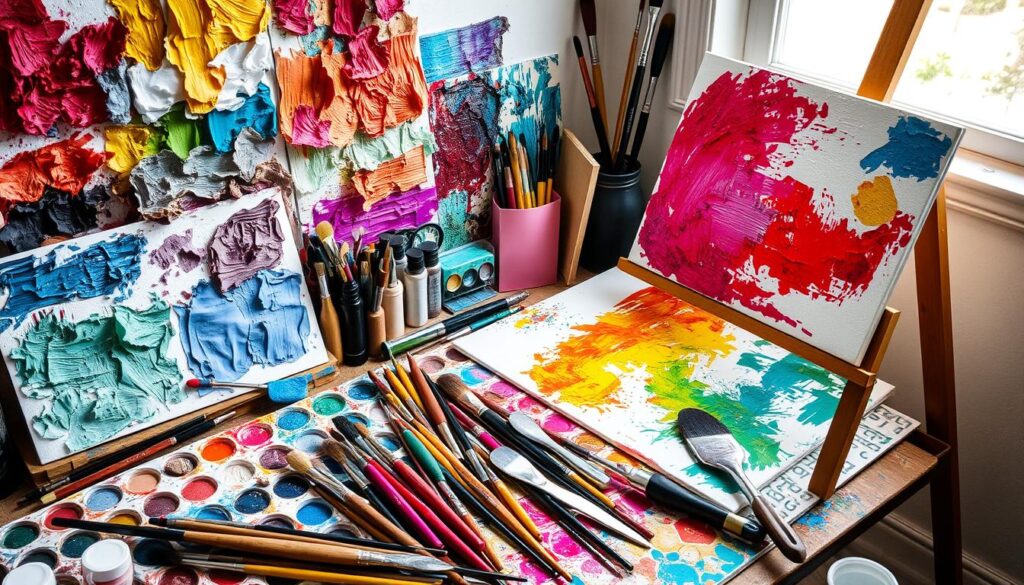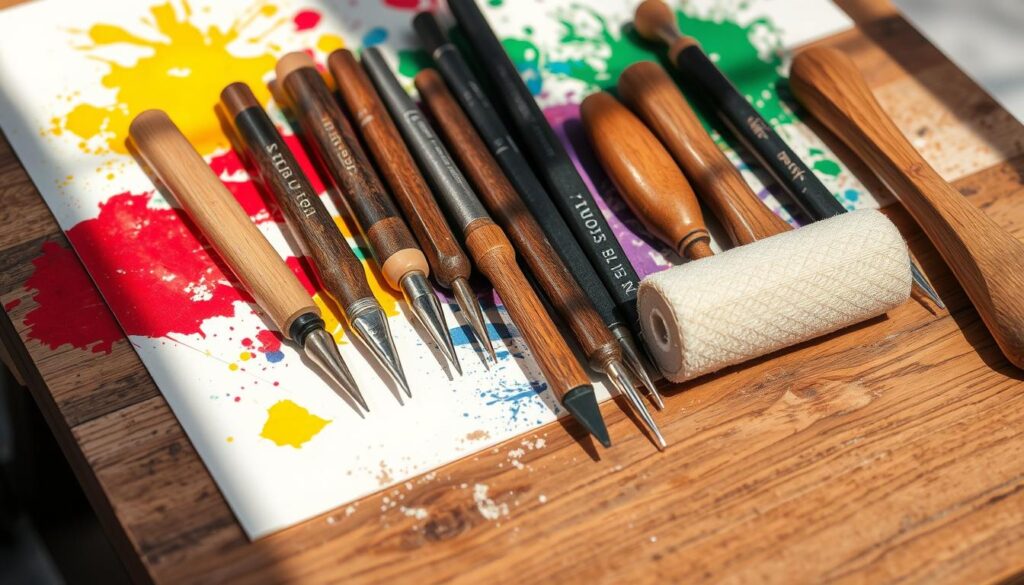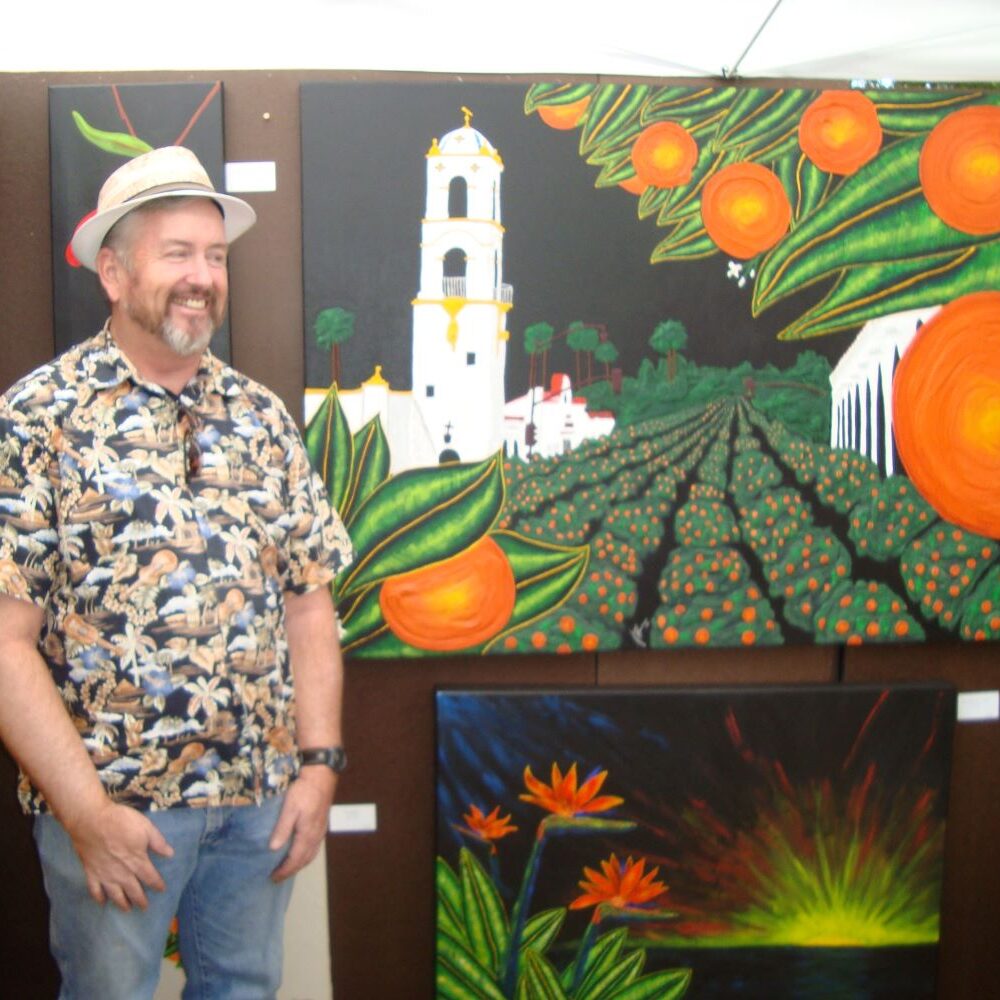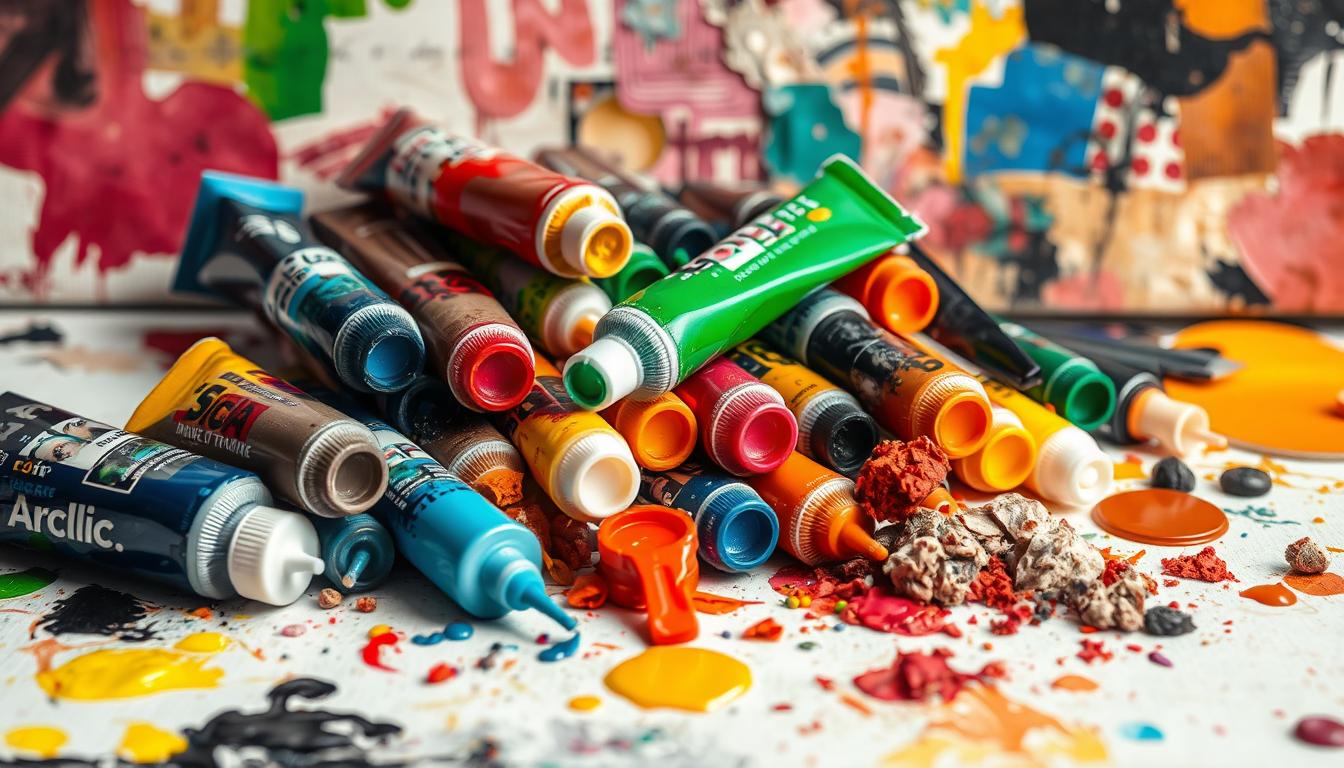This post contains affiliate links.
As an artist, I’ve always been fascinated by texture. It brings paintings to life, adding depth and a touchable quality. Acrylic paints are perfect for exploring many textures, from thick strokes to fine brushwork.
In this guide, you’ll learn about acrylic painting techniques for texture. These techniques will make your artworks more interesting. Whether you’re new to art or experienced, this guide will help you create stunning, textured paintings.
Key Takeaways
- Unlock the full potential of acrylic paints by mastering a range of textural techniques
- Discover how to create depth, dimension, and visual interest in your paintings through the skillful use of texture
- Explore a variety of acrylic mediums, tools, and brushwork methods to achieve unique textural effects
- Gain confidence in experimenting with mixed media techniques to elevate your acrylic paintings
- Learn how to blend colors, apply paint in layers, and utilize specialized techniques like impasto and glazing
Introduction to Textured Acrylic Painting
Acrylic painting techniques that create captivating textures can make your artwork stand out. They add depth, dimension, and a unique, hand-painted look. By mastering acrylic texture painting methods, you can develop a personal style. This brings your artistic vision to life and engages viewers with the tactile quality of your paintings.
Importance of Texture in Acrylic Paintings
Texture is a key element in art that greatly affects the look and feel of a painting. Acrylic painting techniques for texture let you express your creativity in bold, expressive ways. You can experiment with various tools and mediums to achieve captivating visual effects. Textured surfaces can add depth, interest, and a sense of materiality that evokes strong reactions from viewers.
Benefits of Learning Textured Acrylic Painting Techniques
The benefits of learning textured acrylic painting techniques are many. By exploring these methods, you can:
- Develop a unique, personal style that sets your work apart
- Bring your artistic vision to life with greater control and expressiveness
- Engage viewers with the tactile quality and visual interest of your paintings
- Expand your creative possibilities and artistic toolbox
- Discover new ways to communicate emotions and ideas through your art
Embracing acrylic texture painting techniques can be a transformative journey. It allows you to unlock new depths of creativity and connect with your audience in meaningful ways.
Plan Your Textured Composition
Before starting your textured painting, plan your textured acrylic composition. Choose the design or pattern you want, like abstract lines or a realistic subject. Sketch your idea on the canvas or paper to guide you. Think about how the texture will make your painting more interesting.
When planning your textured acrylic painting composition, keep these tips in mind:
- Pick a subject that works well with textures, like landscapes or florals.
- Sketch a basic composition, focusing on element placement and balance.
- Decide on the textures you want, like rough or smooth.
- Try different materials and techniques to get the textures you want.
- Think about how the textures will work with your colors and other elements.
By planning well, you’ll make a painting that’s both cohesive and captivating. It will show off your creativity and skill with texture.
“Texture is the hidden language of the soul.” – Anais Nin

| Technique | Description | Ideal Subjects |
|---|---|---|
| Abstract Textures | Create dynamic, expressive textures using tools like palette knives, sponges, and scrapers. | Abstract paintings, mixed media art |
| Realistic Textures | Capture the nuanced textures of natural subjects like rocks, trees, or fabrics. | Landscape paintings, still life compositions |
| Mixed Media Textures | Incorporate a variety of materials, from paper to found objects, to add depth and dimension. | Collages, assemblages, experimental art |
Create a Thick Base Layer
Starting a textured acrylic painting needs a solid base. Use thick, heavy-body acrylic paint on your canvas or paper. This base is where you’ll add depth and interest to your art.
Materials Needed for the Base Layer
- High-quality, heavy-body acrylic paints
- Small and medium-sized paintbrushes
- Palette knife (optional)
Steps to Apply the Thick Paint Layer
- Pick a color or mix for your base. Think about how it will look with your final touches.
- Put a lot of paint on a brush. Spread it out with big strokes for a textured look.
- Use a palette knife for extra texture. You can make peaks and ridges this way.
- Wait for the base to dry before you do anything else.
The thick paint is your art’s foundation. It’s where you can try different techniques. A good base layer makes your art come alive.
“The base layer is the bedrock of a textured acrylic painting. Invest the time to establish a strong, expressive foundation, and you’ll unlock endless possibilities for your creative exploration.”
Etch Your Design into the Base
After the thick base layer dries, it’s time to etch your design into the acrylic paint. This step, called etching design into thick acrylic base, brings out captivating textures. These textures will be the base of your painting.
Tools for Etching Textures
Try different tools to etch textures in acrylic paintings and find what works best. Use the back of a paintbrush, a palette knife, a toothpick, or even a fork. Each tool makes unique marks and lines, helping you create detailed patterns.
- Paintbrush handles: Use the blunt end to create linear, scratched effects.
- Palette knives: Ideal for scraping and carving out shapes and forms.
- Toothpicks: Perfect for adding delicate, intricate details and patterns.
- Forks: Create interesting, textured impressions with the tines.
Play with different etching techniques to find the textures you like best. Let your creativity lead you in etching design into thick acrylic base.

“Etching into the acrylic base layer allows you to unleash your creativity and add depth and dimension to your paintings.”
Drying the Textured Painting
After etching your design, drying the paint is key before adding more layers. Use a hair dryer to speed up drying. Make sure to dry the whole surface before moving on.
Drying textured acrylic paintings takes time. It may take days, especially if the base layer is thick. You’ll use materials like filler, glue, sawdust, paint, glitter, silver leaf, adhesive, and resin.
To dry your painting faster, try a hair dryer on a low setting. This method can quicken the drying process. Just remember to dry every part of the painting before adding more.
| Tip | Explanation |
|---|---|
| Use a hair dryer on a low setting | This can help speed up the drying time for textured acrylic paintings without damaging the delicate layers. |
| Ensure the entire surface is dry | Check that all areas of the painting have fully dried before adding additional layers or details. |
| Be patient and allow proper drying time | Textured acrylic paintings may take a few days to fully dry, depending on the materials and techniques used. |
Proper drying is crucial for a successful painting. With a dry base, you can add colors and details. This will bring your artwork to life.
Adding Colors and Details
Once your textured base is dry, it’s time to add colors and details. Try layering, glazing, and dry brushing to build up colors and textures. Adding metallic accents like gold or silver can make your textured acrylic paintings shimmer and pop.
Techniques for Adding Color to Textured Paintings
Layering colors adds depth and interest to your textured acrylic paintings. Start with a dark base and add lighter colors gradually. Make sure each layer dries before adding the next. Glazing can also unify colors and add depth.
Dry brushing highlights the texture of your painting. It involves dragging a dry brush across the surface. This technique can make your painting feel more dynamic and textured.
Using Metallic Accents on Textured Paintings
Metallic accents can make your textured acrylic paintings stand out. Use metallic paints or materials like foil to highlight areas. The metallic shine catches the light, adding vibrancy and depth.
Try different ways to apply metallic accents, like sponging or stamping. Mixing these techniques with others, like dripping, can lead to amazing results.
Acrylic Painting Techniques for Texture
Acrylic painting is loved by artists everywhere. It offers endless ways to express creativity. You can make textured, three-dimensional art with acrylics. Learning different techniques can add depth and color to your paintings.
Impasto Techniques with Brushes and Palette Knives
The impasto technique is famous for its thick, expressive layers. Artists like Vincent van Gogh and Jackson Pollock used it. Mixing heavy-body acrylic paint with an impasto medium makes your brushstrokes rich and sculptural.
Use big brushes or palette knives to shape the paint. This creates a textured, three-dimensional effect.
Adding Dry Mediums for Texture
You can also add dry mediums to your acrylic paint. Sand, gravel, fabric scraps, or found objects can be mixed in. This creates a unique, textured surface that grabs your attention.
Try different combinations of dry elements to find your style. This way, you can make each painting special and engaging.
Learning these techniques lets you bring your paintings to life. They become more than just images. They become touchable, expressive pieces of art. Feel free to experiment and see where your creativity takes you.
Textured Effects with Mediums
Unlock your acrylic painting’s full potential with texture-enhancing mediums. These tools open up a world of creativity. They help you create three-dimensional effects that bring depth and interest to your art.
Light Molding Paste for Peaks and Body
Light molding paste is a versatile medium for textures. It’s great for creating ridges, peaks, and depth in your paintings. Apply it to areas and paint over it for stunning three-dimensional effects.
Creating 3D Textured Effects
Acrylic mediums provide many options for creating 3D textured effects in acrylic paintings. You can get a smooth, speckled look with black lava medium or a pulpy texture with blended fibers medium. By using acrylic mediums for texture, you can shape and build your paint surfaces. This creates dynamic, engaging artworks that feel tactile.
“Acrylic mediums offer a world of creative possibilities, allowing you to craft captivating three-dimensional effects that add depth and visual interest to your artwork.”
Mixed Media Texture Techniques
Explore the world of mixed media texture techniques to enhance your acrylic paintings. Use masking tape and modeling paste for layered effects. Try fabrics, gauze, and feathers for striking texture.
Masking Tape and Modeling Paste Textures
Masking tape is great for adding texture to your paintings. Place tape on your canvas and layer modeling paste over it. After it dries, remove the tape to reveal cool patterns and ridges.
Techniques with Fabrics, Gauze, and Feathers
Add unique textures to your paintings with fabrics, gauze, and feathers. Collage fabric or gauze and paint over it for a mixed-media look. Use feathers to show movement and energy in your art.
Try these mixed media texture techniques to make your acrylic paintings stand out. Mixing traditional painting with new materials creates unique and engaging art.
Brush Techniques for Texture
Learning different brush techniques is key to making your acrylic paintings stand out. One great method is dry brushing. It uses a stiff, dry brush to add thin, expressive layers of paint. This technique can make your painting look like fur, grass, or wood grain.
Pair your dry brushing with bold, expressive brushwork for more energy in your paintings. Try out different brush shapes and sizes to get various textures. From the flexible round brush to the detailed detail brush, each brush adds something special to your art.
Dry Brushing and Expressive Brushwork
Dry brushing brings a sense of movement and spontaneity to your acrylic paintings. It lets you capture natural textures and add energy to your work. Mix this with bold, sweeping strokes for an even more dynamic piece.
- Use a stiff, dry brush for thin, feathery strokes that show the surface underneath.
- Try different brush shapes and sizes for different textures.
- Blend dry brushing with bold, sweeping strokes for a lively feel.
| Brush Technique | Desired Effect | Recommended Brush Types |
|---|---|---|
| Dry Brushing | Capture the appearance of natural textures, such as fur, grass, or wood grain. | Stiff, flat brushes or angular flat brushes |
| Expressive Brushwork | Infuse your paintings with a sense of energy and dynamism. | Round brushes, filbert brushes, or fan brushes |
By getting good at dry brushing and expressive brushwork, you can make your acrylic paintings more textured and eye-catching.
Conclusion
This guide has shown you many acrylic painting techniques. Now, you can make your artwork stand out with amazing texture and depth. You can create thick layers or mix different materials for unique paintings. Let your creativity grow as you keep working on your textured style.
Acrylic paints dry fast, making it easy to layer and add texture. Techniques like impasto and mixed media add complexity. Texture gels and pastes let you shape your canvas. These methods open up a world of artistic expression.
Start your textured acrylic painting journey with an open mind. Try new things, face challenges, and enjoy your wins. With every stroke, you’ll find new ways to make your paintings interesting and impactful.
FAQ
What are the benefits of learning textured acrylic painting techniques?
What materials are needed for creating a thick base layer in textured acrylic painting?
What tools can be used to etch designs and patterns into the thick acrylic base layer?
How can you speed up the drying process for textured acrylic paintings?
What techniques can be used to add color and details to a textured acrylic painting?
How can impasto techniques be used to create texture in acrylic paintings?
What types of dry mediums can be incorporated into acrylic paint to add unique, tactile elements?
How can acrylic mediums be used to enhance the textural qualities of paintings?
What mixed media techniques can be used to add unexpected, tactile interest to acrylic paintings?
How can brush techniques like dry brushing be used to create textural effects in acrylic paintings?
This post contains affiliate links.

